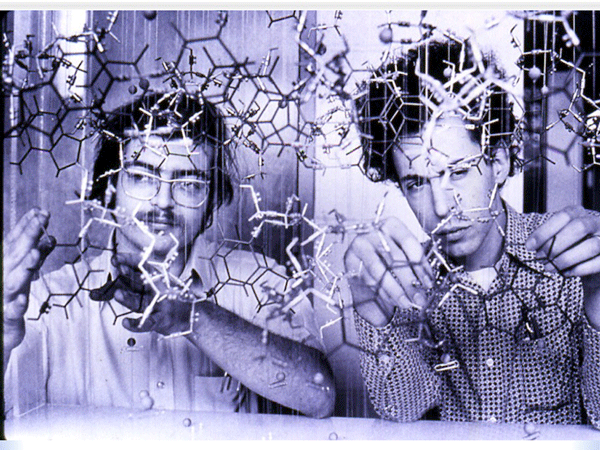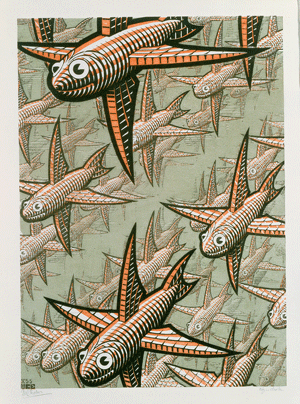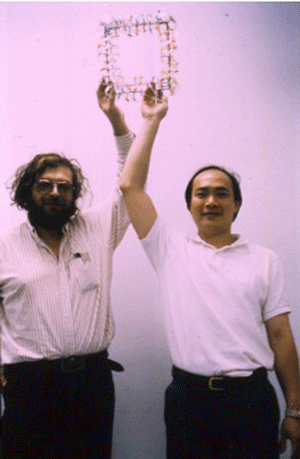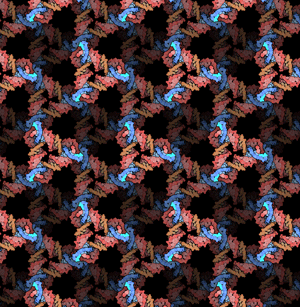Memoir - Nadrian C. Seeman (1945 - 2021)Memoir | Publications | Curriculum Vitae | Videos | Slides | Articles | Obituary
The Crystallographic Roots of DNA Nanotechnology Nadrian C. Seeman 2014
I was born in Chicago at the end of 1945 as an only child in a middle-class Jewish family. My father sold fur garments in Chicago (from 1953 in his own store), but after my birth my mother did not return to teaching until my grandmother died in 1963. In 1951, we moved to the suburb of Highland Park, where we remained until I went to college in 1962. I was a quiet child who preferred reading over sports, a characteristic that has persisted. Sputnik was launched in October, 1957; a year later, I became a "Sputnik Kid" who was brought daily to the high school in the early morning, where I took a special algebra class, before spending the rest of the day at my middle school. As a nocturnal person, I didn't do all that well, but I was set on a path of advanced math and science courses from then until the end of high school. A year earlier, my father had begun a campaign to convince me that I wanted to be a physician. The math and science that I liked were not incompatible with my father's goal, so he gave me no flack about them. At about the time I got to high school, I lost whatever faith I might have had, and I've been an atheist ever since. The most important scientific influence in my early life was my high school freshman biology teacher, John E. Broming. The school year was divided into six 6-week segments, and he devoted the first of these to teaching the class the rudiments of chemistry and physics as they applied to the structure of matter; this emphasis instilled in me the sense that life is a physico-chemical phenomenon, and that's where my intellectual center has been ever since, on the cusp of the physical and biological sciences, at the edge of life. In addition, when we did get to biology, I found it was pretty neat, with lots of nifty structures and shapes and an apparently logical nature that appealed to me. I got a high school diploma at the end of my third year and went off to the University of Chicago as a pre-med. At the time, I didn't yet know that my job as a professor of science existed: I thought a university professor did the same thing as a high school teacher, only teaching more advanced material. I had no idea that I could spend most of my day having fun doing research and also get paid to do it. That was the most important thing I learned at Chicago. It was damn near the only thing I learned. As Mark Twain put it, I didn't let college interfere with my education. I was a poor student, getting grades that were mediocre on a good day, and there weren't many of those. The only things I remember from my undergraduate science courses are the Watson-Crick pairing rules, that A pairs with T and G pairs with C. My grandmother died during my first year in college, and I recognized both the inevitability and finality of death. The notion of spending my life keeping other people alive for a few extra years lost any appeal it might have had for me. When I learned that a university career offered the pleasures of doing research, I announced to my parents that I wanted to become a biochemist, which I thought was the area closest to my interests. My father greeted my decision to become a scientist instead of a physician much as I imagine he would have welcomed a career choice of mobster. Biochemistry at Chicago in the middle 1960s turned out to be a great disappointment. The field as taught at that time treated little of the information content of molecular biology, which I sensed was really neat. Rather, it had been developed by organic chemists, and was basically the study of the metabolic transformations of small molecules, not the study of the macromolecules whose information content made biology special. When the realization of what biochemistry seemed to be all about sank in, I switched to physical chemistry, where I didn't do well, either. In the end, I was rejected by all the chemistry graduate schools to which I applied. I went to the Chemistry Department's advisor to present my predicament: I asked, "Nobody wants me. What can I do?" His reply was, "That's not true. Uncle Sam — he wants you!" This remark was uttered in the middle of the Vietnam War, to which I was staunchly opposed, both because of my left-wing politics, and also because I didn't want to return from Southeast Asia as a putrefying corpse in a body bag. I stumbled out of his office and had no idea what to do with my life. Nevertheless, I managed to stay draft-resistant by fast-talking my way into Chicago's graduate Biochemistry Department, where I didn't do much better in the basic biochemistry courses the second time around. During my spring vacation that year one of my roommates and I took a drive-away to San Francisco; the 46 hour continuous drive to Reno (as far as the car was going — we rode a bus the rest of the way) with minimal sleep gave me hallucinations without drugs, and cleared a lot of cobwebs from my brain. I spent the week walking around Golden Gate Park, and decided that perhaps there were interesting things to be done in science, even though Watson & Crick and Monod & Jacob seemed to have solved all the big problems of which I was aware. I did a lot better the following quarter, but my performance was still inadequate. The key difference this time was the graduate student advisor in biochemistry, John H. Law. He saw that I was probably talented, but was not really interested in what was offered there. At the end of the year, he told me I should leave, and managed to get me into the new crystallography/biochemistry training program at the University of Pittsburgh. This was the single greatest favor anybody did for me before I left Chicago. Pittsburgh was a totally different experience. I was immediately engaged in crystallography research, which turned out to be a lot of fun. Between Bryan Craven's crystallography course, Bob Rosenstein's tutelage and Helen Berman's friendly advice, I learned how to do crystallography, and more importantly how to think about 3D structure and symmetry. The laboratory was run by G.A. Jeffrey (Jeff), whose gentle directing hand kept us fairly happy and adequately funded. Bob Stewart's Friday afternoon seminars at the Craig Street Inn taught me that one could learn, discuss and think productively about Science over beers. I have probably never done anything that I enjoy as much as solving high-resolution small molecule crystal structures, both in Pittsburgh and later, but deep down the purely analytic nature of crystallography left me unsettled. Nevertheless, I was having fun and I was doing well, so I figured that I could deal with whatever problems there were at a later time. The world was never far from us in those days; I solved my first crystal structure in 1968, presented it at the August American Crystallographic Association meeting in Buffalo, and returned to find a notice from my draft board that I had been re-classified 1A (prime candidate for drafting) and was soon called for my physical examination. Knowing a little about physiology, the morning of the exam I ate a quarter pound of butter (absorbed into garlic bread — could halitosis get me out of the army?) and a quart of soft ice cream; I was able to urinate sugar for them, enabling me to fail the physical. During my second year in Pittsburgh, I finally came to terms with my father, whom I convinced I was not a bum, even though I wanted to become a scientist. We had a tolerable relationship for the remaining 20 months of his life: I handed him my thesis and he dropped dead the following day. I got my degree in August, 1970, my self-confidence restored (arguably over-restored), and went off to Columbia University as a postdoc to work on the protein-folding problem, which I then believed to be important, interesting and (foolishly) tractable. I went to the laboratory of a prominent pompous person who turned out to be of lightweight intellectual heft. Within four months, I realized I had made a serious mistake, and started trying to leave for what had been my primary other postdoctoral possibility, Alex Rich's laboratory at MIT. To do so entailed getting fellowships, so I suffered in the Columbia laboratory for over a year until they kicked in. In the meantime, I was instrumental in the solution of the first dinucleoside phosphate structure, and I garnered a little notoriety that way.
Nadrian C. Seeman and John Rosenburg with the ApU structure showing Watson-Crick base pairing (1973).
It's worth pointing out that I had crystallized none of the dinucleoside structures myself - I had just used my structure-solution skills in their determination. The structure containing the Watson-Crick A-U base pairs was a lucky punch. I hadn't designed the crystal; it just happened. The final dinucleoside structure I solved contained an intercalating drug, 9-aminoacridine, but it was an unlucky punch; I didn't find the intra-helical intercalation I had sought, and it was the hardest of all to solve. It left a somewhat bitter taste in my mouth to have so little control over the structure of the crystal, a problem I would ultimately address. I have a Chinese fortune cookie strip taped to my refrigerator, "Failure teaches success". The failure I experienced with the 9-aminoacridine crystal reminded me of the analytical nature of crystallography, with no control over the structure. I began to think about ways to control crystalline structure, thinking that ultimately led to my thinking up DNA nanotechnology. By 1974 the crystallographic game was changing. Solving small molecule structures was becoming less and less important, and the key skill transformed from being good at solving structures to being good at crystallizing important macromolecules, usually proteins. I was totally unskilled at generating crystals, never absorbing the subtleties of the trial and error ("pee in a pot and pray") approach. I also had become unenthusiastic about proteins: nucleic acids are very general, but every protein seems to be unique. I am just not suited to devoting years of my life (which it took in those days) to isolating, producing, and teasing out the structure of one of thousands of different proteins. Furthermore, my experiences with tRNA in Alex's lab made me somewhat uncomfortable with the lower resolution of macromolecules. This placed me in a bit of a quandary. In addition, the mid-1970s were a bad time to be seeking an independent position as a biological crystallographer: We were considered expensive, and those of us competing for jobs were often vying with non-crystallographers, whom the hiring departments preferred. Despite my postdoctoral successes, I had to spend two years seeking an independent position, and was turned down by all the desirable and most of the undesirable departments where I interviewed. I used to kick the wall in my bedroom from frustration: I had spent almost a decade at my work, was widely recognized (at least at ACA meetings), and still I could not get a job. The hole in the wall wound up with a diameter over half a meter. Eventually, I landed a position in the Biology Department at SUNY/Albany. The only thing worse than looking for a job was finding this one, because Albany was in many respects a scientific death sentence. Unlike MIT, many of my colleagues seemed far more interested in their families than in their science. In my generation, many of the students in biology/biochemistry departments had the same appreciation of the importance of chemistry and physics that I did, but that tradition had died out by the time I got to Albany. The graduate student complement in Albany consisted largely of mathophobic failed pre-meds, and during my first seven years I recruited no graduate students, and as a beginner at an undistinguished institution, I attracted only ineffective postdocs. Without a full-time labor force, I was unable to grow crystals of anything interesting to me or to anybody else, and thus was unable get my crystallographic act in gear. The good thing that happened in Albany was that in the fall of 1978 Bruce Robinson (a postdoc with Leonard Lerman at the time) came into my office and asked if I could build a model of a Holliday Junction, a DNA branched junction structure that is an intermediate in genetic recombination. When we looked at the model, we discovered some asymmetries that we thought might have some impact on the kinetics of branch migration. I had nothing else working for me, but as a crystallographer, I had learned to write programs; I wrote some code that simulated the process, and I started thinking about branched DNA. One of the problems with what Bruce and I were doing was that any hypotheses we might generate were untestable. This was because the symmetry of naturally-occurring branched molecules led to branch migration, whereby the branch point migrates all over the place, producing a polydisperse solution that ultimately resolves to duplex DNA. Thus, our project started off as a scholastic enterprise, rather than a scientific one. In the spring of 1979, I flew with Greg Petsko to the ACA meeting in Honolulu. During the flight, Greg mentioned that it might be possible to crystallize structures resembling intermediates in the hemoglobin oxygenation pathway by mixing iron-containing hemoglobin with cobalt-containing hemoglobin. This comment planted a seed in my head that one could use tricks to prepare analogs of intermediates like the Holliday junction. About a month later, that seed grew into the notion that by using synthetic DNA one could eliminate the symmetry inherent in naturally-occurring branched molecules, resulting in immobile branched junctions. This would enable us to test hypotheses, and also perhaps allow structural characterization.
M.C. Escher's "Depth" (c) 2014 The M.C. Escher Company - The Netherlands. All rights reserved. www.mcescher.com
I was elated with this idea, and started building physical models; I showed one to a visitor who asked if it were possible to make junctions with more arms than the four in a Holliday junction. I had no idea, but soon worked out that an evident structural constraint would permit up to eight arms in an immobile junction, although that is no longer the limit. In September, 1980, I went to the campus pub to think about 6-arm junctions. Because it was easy to draw them with hexagonal symmetry, I had thought about them that way, before entering the bar. While drinking a beer, I suddenly thought of Escher's woodcut "Depth" containing fish with three orthogonal axes (a head and tail, two vertical fins and two horizontal fins), making them topologically isomorphous with six junctions. Furthermore, the fish in that woodcut are organized periodically in 3D, just like the molecules in a molecular crystal. However, thinking of the fish as nucleic acids, I imagined their contacts being programmed by sticky ended cohesion; these are single-stranded intermolecular interactions that occur between the overhangs that arise when one strand of a DNA duplex is a little longer than the other. Sticky ends were familiar, because they had been used by genetic engineers since the early 1970s. Thus, I had the idea of self-assembling crystals with pre-defined intermolecular contacts, rather than using trial and error. I've had a number of insights in my life, but this was my major epiphany. I realized that branched DNA molecules could be self-assembled into N-connected objects, lattices and other networks using the specificity of sticky ends; this was thinking that remained with me from my days in Jeff's clathrate hydrate lab, although I had only kibitzed on those projects. The idea felt great — it still entailed working with nucleic acids, it still involved symmetry and crystallography, but now I imagined that I would have a target for my creative urges, designing DNA objects and lattices. I re-oriented my research direction towards implementing this idea, even though it was extremely dangerous to do so in the fourth year of my five-year assistant professorship. Nevertheless, this notion has grown into the field of DNA nanotechnology. It took a long time. I started collaborating with Neville Kallenbach, then at Penn, who taught me how to work with DNA in solution. He also bought the DNA that made the first immobile junctions, although I eventually learned how to make it myself. The biggest favor Neville did for me was to hire me in 1988 at New York University's Chemistry Department, where he had become chair. After 4000 days (OK, 3983, but I round off), I was rescued from the uncomfortable small-town milieu of Albany. As a friend of mine put it,"It is one thing to be a big fish in a little pond and another to be a little fish in a big pond: It is something entirely different to be a fish out of water." On the scientific front, the move solved my labor problem: Rather than being a person on the fringes of a Biology Department, my interests were relatively mainstream in a Chemistry Department, and I rapidly attracted students.
Nadrian C. Seeman and Junghuei Chen with DNA cube-like catenane (1990).
The very first thing I did in my NYU laboratory was to synthesize the strands for a DNA cube-like catenane, built in 1990 by my first Ph.D. student, Junghuei Chen. This was the key founding experiment of structural DNA nanotechnology. This is DNA nanotechnology, where the DNA sequence is used to program the structure assumed by the DNA molecules, and is not just the use of DNA whose complementarity allows it to be used as smart glue. John Mueller, my second Ph.D. student, built a deliberate knot a year later, thereby establishing the area of synthetic single-stranded DNA topology. Tsu-Ju Fu first built small DNA double crossover (DX) molecules (analogs of meiotic intermediates) in 1993, and a year later, in a rotation exercise, Xiaoping Yang showed that these were rigid motifs that could be used in DNA nanotechnology to build both lattices and nanomechanical devices. In the spring of 1995, I attended the first meeting on DNA-based computation, where I met Len Adleman, Erik Winfree and Paul Rothemund. In his talk, Erik proposed that he could use our system, 4-arm branched DNA molecules with specific sticky ends, as cellular automata. We hadn't yet published the rigidity of DX molecules, so I suggested that he use them instead of 4-arm junctions, which we had shown were flexible. After I visited Caltech, Erik and I began a collaboration, which resulted in the first 2D DNA crystalline arrays. In addition, I became a member of the DNA-based computation community, which has been the source of many of the people who have moved into DNA nanotechnology. In the ensuing years, we extended DNA nanotechnology to include robust nanomechanical devices, walkers, and ultimately an assembly line.
Self-assembled DNA triangle crystal structure (November PDB Molecule of the Month by David Goodsell).
So what about 3D crystals? As soon as the 2D arrays were produced, we started trying to self-assemble 3D crystals. We had a lot of crystals, but we did not get crystals with adequate resolution. We were using 2D motifs that we converted to 3D motifs by connecting them with a non-half-integral twist; these worked very poorly. However, my former student, Chengde Mao, now in his own lab, developed what he called the "tensegrity triangle", a robust motif whose helix axes are oriented in linearly independent directions. When we made the edges short enough, the crystals diffracted to 4 Å resolution, and our crystallographic team, led by Jens Birktoft, was able to determine the structure through SAD, using iodinated nucleotides. It had been only 29 years since my afternoon in the Albany campus pub. From the foregoing, it should be clear that I regard the entire field of DNA nanotechnology to be an outgrowth of crystallography and crystallographic thinking. In work we plan soon to publish, we have shown that it is possible to improve the resolution of crystals held together by sticky ends just by fiddling with the sticky ends. We now have 3Å or slightly better resolution of the same crystals. We have not yet developed good crystals whose cavities are large enough to act as hosts for other macromolecules, a key part of my original proposal for DNA nanotechnology. I'm glad all the problems aren't solved yet, and it's exciting to have major goals stretching before me, particularly when they are crystallographic goals. Ned Seeman
|






